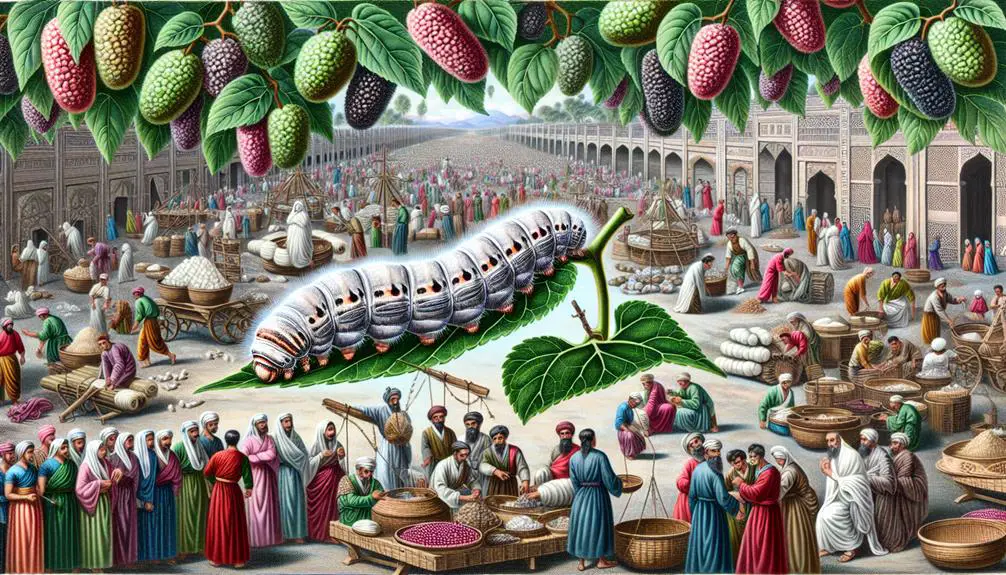Silk is essential in global economies, contributing to trade, jobs, and luxury markets. It's a fabric that intertwines history and opulence, shaping industries worldwide. The silk industry not only adds richness to economies through trade but also offers diverse job opportunities. Silk trade generates substantial revenues, benefiting producing nations. From high-end fashion to cultural exchange, silk weaves through various aspects of the economy, symbolizing elegance and prosperity. Its economic importance extends far beyond mere fabric, impacting nations and individuals alike. Explore how silk continues to influence diverse sectors and economies globally.
Table of Contents
Key Takeaways
- Silk industry contributes billions to global economy annually.
- Silk exports boost GDP and create job opportunities.
- Silk products diversify income sources for farmers.
- Silk trade historically shaped global economies.
- Silk's luxury market demand drives innovation and growth.
Silk Industry Contribution to Global Economy
The global silk industry plays a pivotal role in shaping the economy, reflecting its significant impact on a worldwide scale. With the silk industry accounting for 0.24% of global fiber use annually, it holds substantial economic importance. Leading producers like China and India showcase the industry's reach, contributing to the global economy. Silk production, ranging from 70,000 to 900,000 metric tons yearly, further highlights its economic significance.
The projected growth of the global silk market to USD 32.06 billion by 2029 emphasizes the industry's substantial economic impact. However, challenges such as competition from artificial fibers and environmental impacts pose threats to the industry's growth potential. These challenges necessitate strategic solutions to sustain the economic contribution of the silk industry in the ever-evolving global economy. Despite these obstacles, the economic importance of silk remains undeniable, making it an essential player in the global economic landscape.
Job Opportunities in Silk Production
Exploring silk production opens up a world of diverse job opportunities, particularly in regions abundant with labor resources. The sericulture industry, known for being labor-intensive, provides employment opportunities that don't necessitate significant capital investments.
From silkworm rearing to cocoon harvesting, silk extraction, and weaving processes, there exists a range of roles waiting to be filled. These job opportunities play an important role in rural areas, contributing to economic growth and development. The various stages involved in silk production not only offer employment but also cater to a wide array of skill sets.
As individuals engage in activities like raising silkworms and weaving fabrics, they play a crucial part in sustaining the sericulture industry. Overall, the employment opportunities within silk production not only benefit individuals but also support the overall growth and prosperity of the regions involved.
Export Revenues From Silk Trade
Considering the substantial contribution to global economies, export revenues from the silk trade represent a significant financial boon for silk-producing nations. The export revenues from the silk trade are essential for the economy and growth of these countries, especially China and India, which are major players in the silk industry.
The following points highlight the importance of export revenues from the silk trade:
- Billions in Revenue: Silk trade generates billions of dollars in export revenues annually, contributing immensely to the GDP of silk-producing nations.
- Economic Impact: Silk exports play a pivotal role in boosting the economy of these countries, creating a ripple effect on various sectors.
- Employment Opportunities: The silk industry provides job opportunities for a considerable number of people, supporting livelihoods and economic stability.
- Global Demand: The high demand for silk products in international markets is a driving force behind the export revenues, ensuring a steady flow of income for silk-producing nations.
The export revenues from the silk trade not only bolster the economy but also foster growth, sustainability, and prosperity in these nations.
Economic Impact of Silk Products
Pivoting from the important export revenues derived from the silk trade, the economic impact of silk products extends far beyond mere financial gains, encompassing a broader spectrum of benefits for countries involved.
Silk products play a vital role in the economic development of nations by providing income opportunities for farmers and bolstering rural economies. The global market for silk is poised to hit USD 32.06 billion by 2029, highlighting the substantial economic influence of silk products.
Diversification of silk items and value addition can further enhance the economic potential of sericulture. Key products such as silk thread, pupae cake, pupae oil, larvae, moths, and eggs not only boost farmers' incomes but also contribute significantly to the overall economy.
Despite facing challenges like competition from alternative fibers, leveraging the by-products of sericulture presents new avenues for development and economic growth in regions reliant on silk production.
Cultural Exchange Through Silk Trade
The Silk Road, a historic trade route spanning continents, fostered profound cultural exchanges through the trade of silk. This exchange wasn't only about the physical goods but also the sharing of ideas, beliefs, and innovations between civilizations.
- Spread of Chinese Silk Production Techniques: Chinese silk production techniques and designs were disseminated to other regions, enriching the diversity of silk products worldwide.
- Symbol of Wealth and Luxury: Silk was highly esteemed in ancient trade, symbolizing wealth and luxury. Its value transcended mere economic transactions and carried deep cultural significance.
- Shaping Global Economies: The trade of silk played a pivotal role in shaping global economies, influencing markets and trade routes across vast distances.
- Fostering Intercultural Interactions: The Silk Road connected diverse civilizations, facilitating not only economic transactions but also the exchange of traditions, beliefs, and technologies. This intercultural interaction helped in the enrichment and evolution of societies along the trade route.
Sustainability in Silk Farming
Embracing sustainable practices in silk farming enhances both environmental conservation and ethical considerations in the sericulture industry. Sustainable silk farming methods like peace silk production, which allows moths to emerge naturally before harvesting the cocoons, and wild silk farming, such as Tussar silk production in open woodlands, not only promote biodiversity but also offer more durable fabric choices. Gandhi advocated for Ahimsa silk and wild silk production as eco-friendly and ethical alternatives in sericulture, emphasizing the importance of ethical practices in silk production. By incorporating these sustainable methods, we support rural economies, improve silk production quality, and uphold eco-friendly standards in the industry.
| Sustainable Silk Farming Methods | Description | Benefits |
|---|---|---|
| Peace Silk Production | Allows moths to emerge before harvesting cocoons | Ethical and environmentally friendly |
| Wild Silk Farming (e.g., Tussar silk) | Produced in open woodlands, promoting biodiversity | Durable fabric options |
| Gandhi's Ahimsa Silk | Advocated for ethical alternatives in silk production | Supports eco-friendly practices |
Benefits of Silk in Fashion Industry
In exploring the fashion industry's domain, silk reigns as a luxurious and highly esteemed fabric known for its natural sheen and vibrant hues. The benefits of silk in the fashion industry are numerous:
- Luxurious Fabric: Silk is revered for its sumptuous texture and appearance, adding a touch of elegance to any garment.
- Natural Sheen: The inherent luster of silk enhances the overall look of clothing, giving it a glossy and high-end finish.
- Vibrant Colors: Silk's dye-friendly nature allows for a wide range of vivid colors, making it a popular choice for designers looking to create visually striking pieces.
- High-Quality: The fashion industry values silk for its premium quality, excellent drape, and resilience, ensuring that garments made from silk stand the test of time in terms of both style and durability.
Silk's reputation as the Queen of Textiles is well-deserved, as it continues to play a crucial role in the creation of exquisite and sought-after clothing items.
Silks Role in Luxury Goods Market
Silk plays a pivotal role in the luxury goods market by influencing the demand for high-end fashion items. Its association with elegance and sophistication makes it a symbol of status and exclusivity.
The allure of silk's natural sheen and vibrant colors contributes to its high value in creating luxurious products.
Luxury Market Influence
With its opulent feel, vibrant colors, and exclusive appeal, silk plays a pivotal role in the high-end luxury goods market.
- Silk is highly prized for its opulent feel, sheen, and vibrant colors.
- The luxury market includes high-end fashion, home furnishings, and accessories.
- Affluent consumers are drawn to silk's exclusivity and elegance.
- High-end silk products command premium prices, contributing greatly to the luxury goods industry.
Silk's economic importance in the luxury market is undeniable, as it drives demand for high-quality silk production and innovation. Its desirability among the affluent clientele ensures that silk remains a cornerstone of the luxury goods market, maintaining its status as a symbol of sophistication and opulence.
High-End Fashion Demand
Luxury fashion houses capitalize on silk's luxurious texture, vibrant colors, and historical association with sophistication to drive demand in the high-end fashion market.
Silk's natural sheen and ability to create exquisite draping make it a preferred fabric for high-end designers, adding elegance and class to their creations.
This historical symbol of luxury plays an important role in the economic significance of silk within the luxury market.
Premium fashion brands continue to favor silk for its unique properties, further solidifying its position as a sought-after material in luxury fashion.
As consumer demand for high-quality silk persists, the fabric remains a cornerstone of the high-end fashion industry, highlighting its enduring importance in the world of luxury goods.
Symbol of Status
Historically revered for its association with opulence and exclusivity, the allure of silk as a symbol of status in the luxury goods market remains unyielding. Silk's presence in high fashion and designer clothing epitomizes exclusivity and prestige, enchanting discerning consumers seeking luxury.
The economic importance of silk lies in its ability to command premium prices, catering to a niche market of individuals valuing sophistication and elegance. The demand for silk as a status symbol has fueled a global industry dedicated to producing high-quality, luxurious fabrics, further solidifying its position as a coveted commodity.
- Silk epitomizes exclusivity and prestige in the luxury goods market.
- The economic value of silk is derived from its ability to command premium prices.
- Silk caters to a niche market of individuals valuing sophistication and elegance.
- The global silk industry focuses on producing high-quality, luxurious fabrics for discerning customers.
Foreign Exchange Earnings From Silk
Silk holds immense value in terms of foreign exchange earnings for countries like China and India. The revenue generated from silk exports plays a vital role in balancing trade deficits and strengthening economies.
The impact of silk trade on foreign exchange underscores its significance in supporting economic development and stability in silk-producing regions.
Silk Export Revenue
Export revenue from silk plays an important role in boosting the economies of countries like China and India, serving as a substantial contributor to their foreign exchange earnings.
- China, as the largest global silk exporter, generates considerable foreign exchange revenue.
- India's economy benefits significantly from silk export earnings, particularly from mulberry silk varieties.
- Silk export revenue reflects the international demand for silk products and underscores the economic importance of the silk industry.
- Foreign exchange earnings from silk exports not only support economic growth but also help maintain a favorable trade balance for silk-producing nations.
Trade Balance Impact
Playing a crucial role in trade balance and economic stability, the foreign exchange earnings from silk trade serve as an essential driver for growth in silk-producing regions. Countries with a strong silk industry benefit greatly from valuable foreign exchange earned through silk exports, contributing to a positive trade balance.
This influx of foreign exchange revenue not only supports economic development but also enhances international trade relations. The high demand for silk in global markets further boosts foreign exchange reserves, strengthening the economy of silk-producing regions.
The silk industry's ability to generate substantial foreign exchange earnings underscores its essential importance in sustaining economic growth and stability.
Frequently Asked Questions
What Is Silk Important For?
Silk is crucial for luxury, comfort, and style. It's essential for high-end fashion and home goods. Its economic importance lies in generating income, creating jobs, and contributing to foreign exchange earnings, especially in developing nations.
Why Was Silk Important to Us Today?
Silk holds economic significance today due to its labor-intensive production, high income potential, and role in generating employment. Its luxurious quality and demand across industries contribute to its importance in global economies, enhancing prosperity.
How Does Silk Impact the World?
Silk impacts the world by supporting millions of livelihoods, fostering economic growth, and promoting cultural exchanges. Its global market value in billions and historical significance demonstrate its vital role in trade and sustainability.
How Has Silk Impacted Society?
Silk, a symbol of luxury and elegance, has deeply impacted society. Its allure transcends borders, fostering cultural exchange and economic growth. The demand for silk has fueled innovation, supported livelihoods, and continues to shape traditions globally.
- How to Make a Fabric Glasses Case: A Simple Sewing Project - June 25, 2025
- Create a Custom Ipad Case Out of Fabric: a Padded Sleeve Tutorial - June 25, 2025
- How to Make a Roll-Up Fabric Pencil Case for Artists and Students - June 25, 2025







